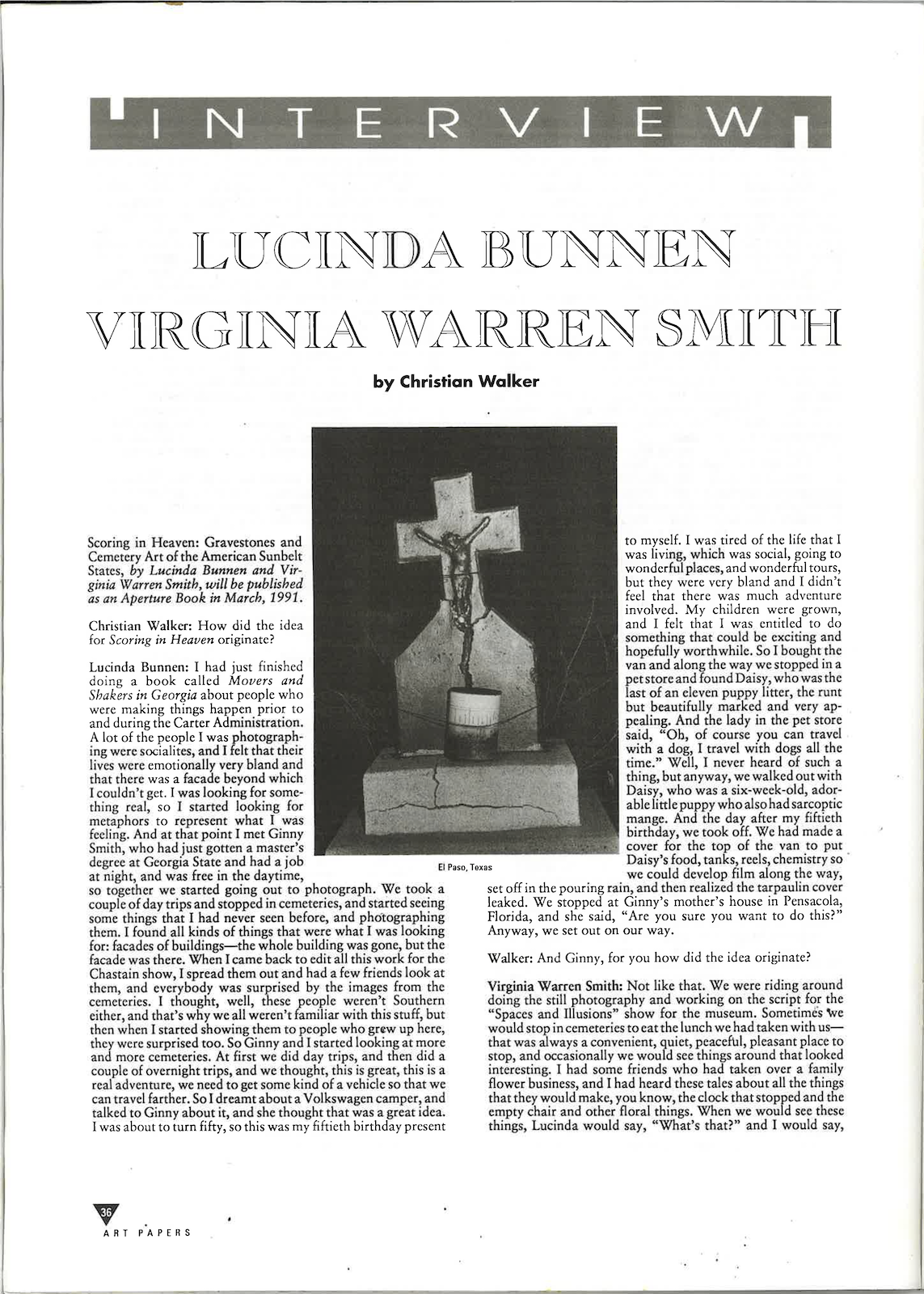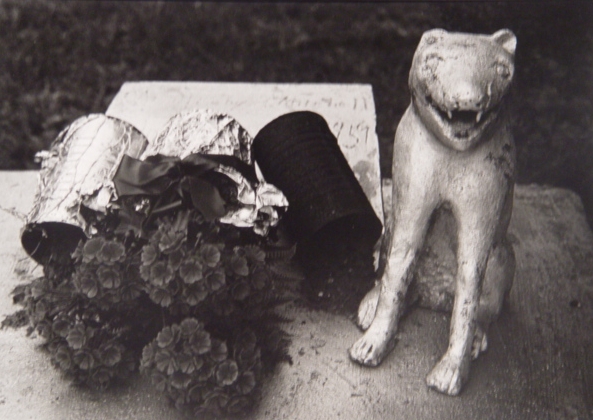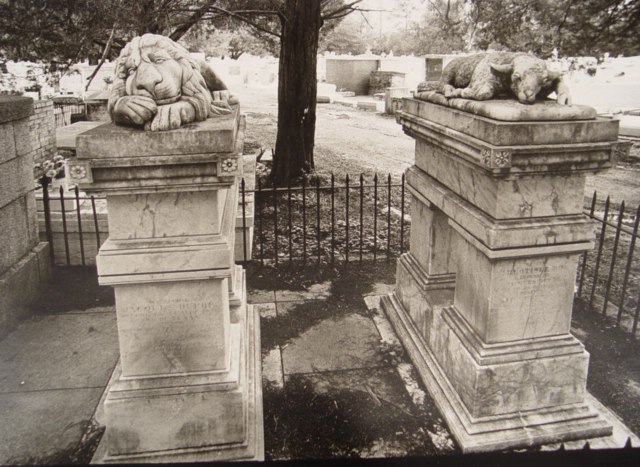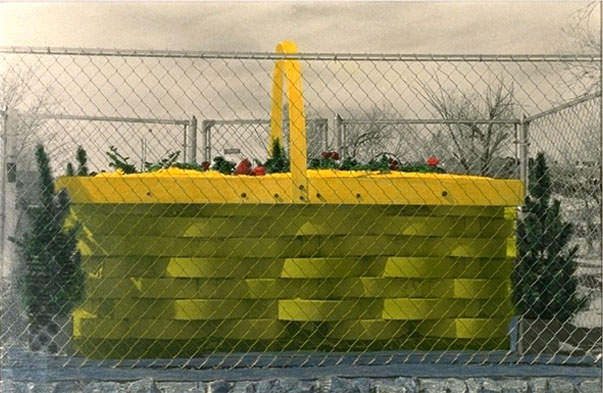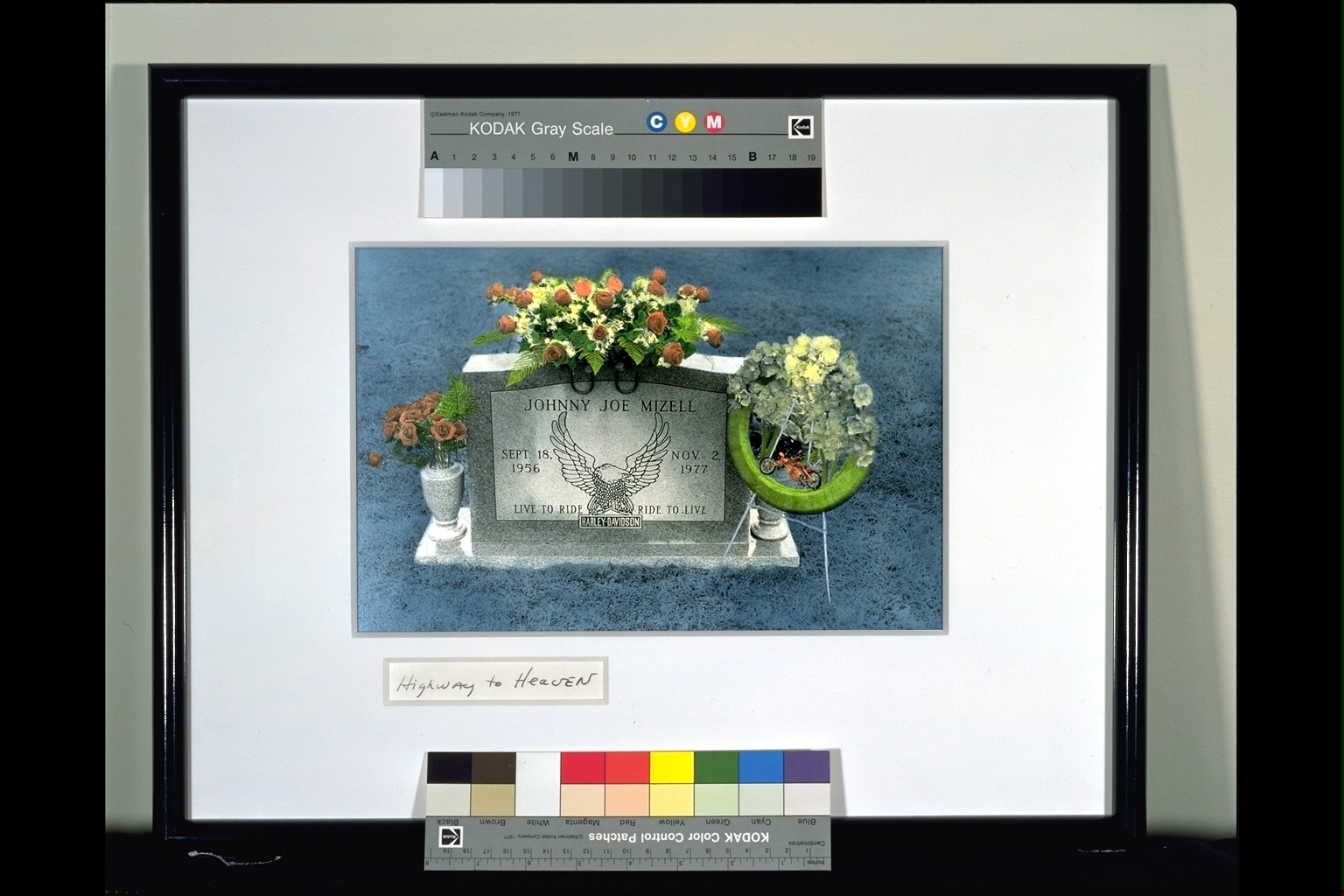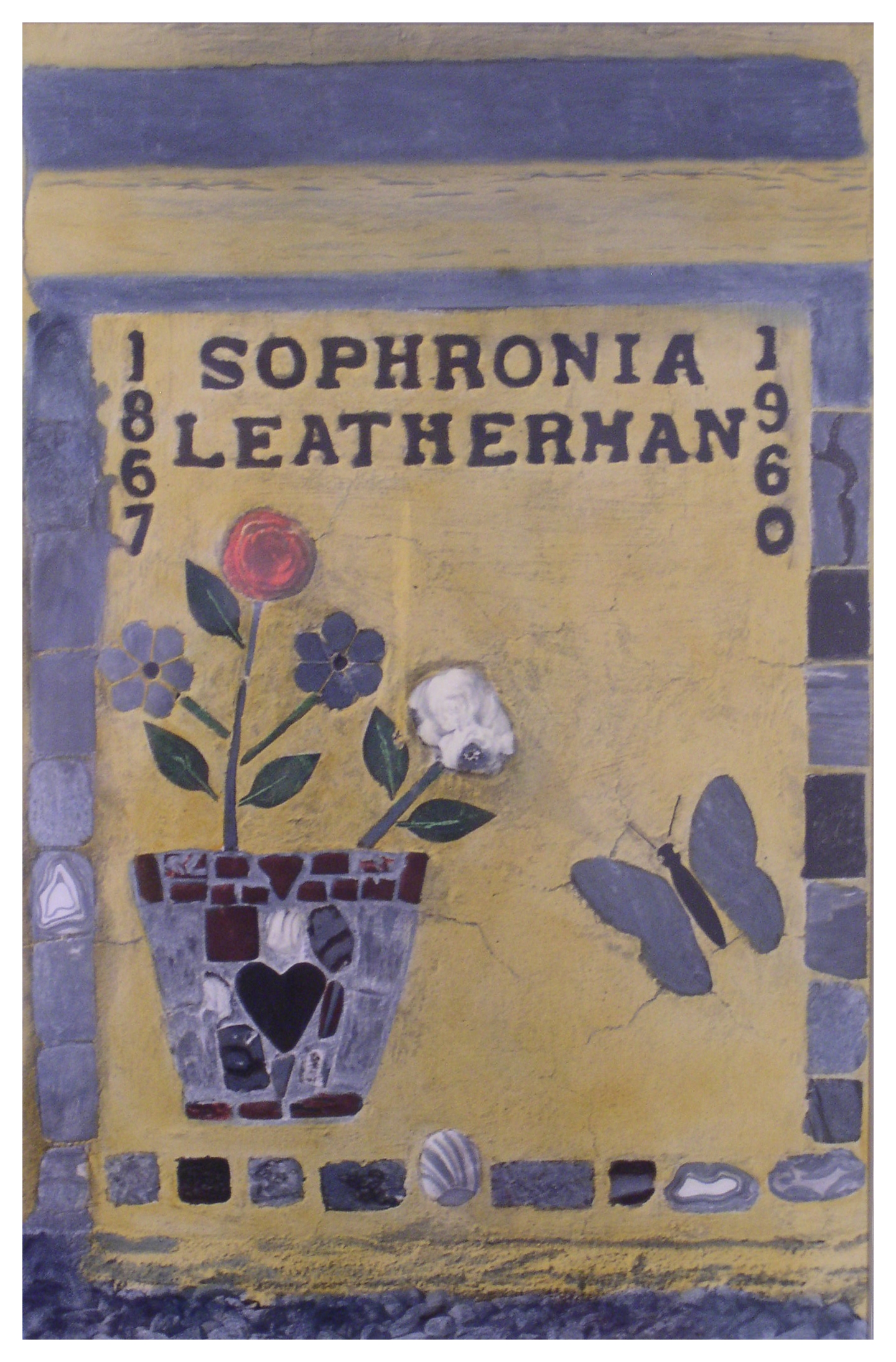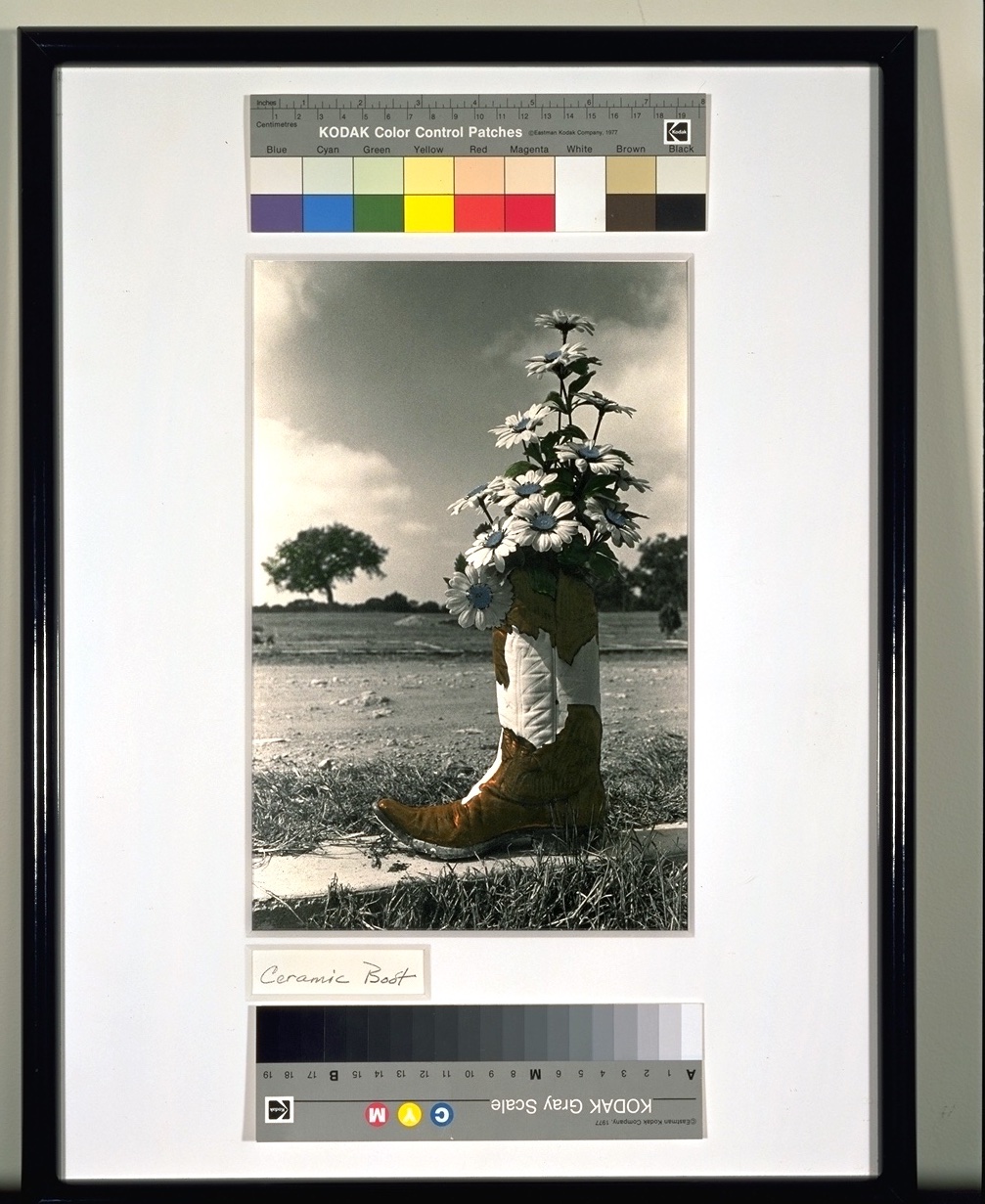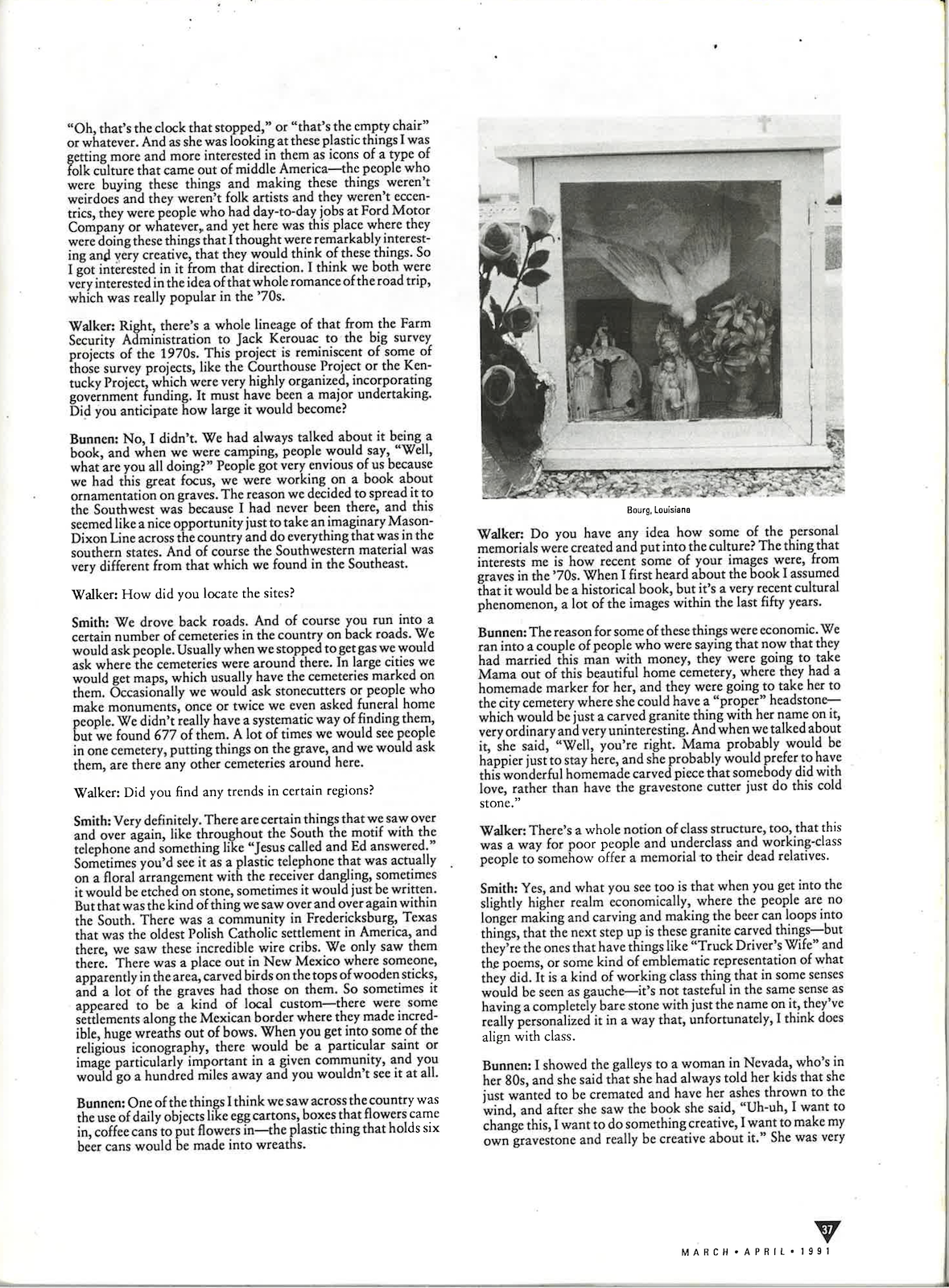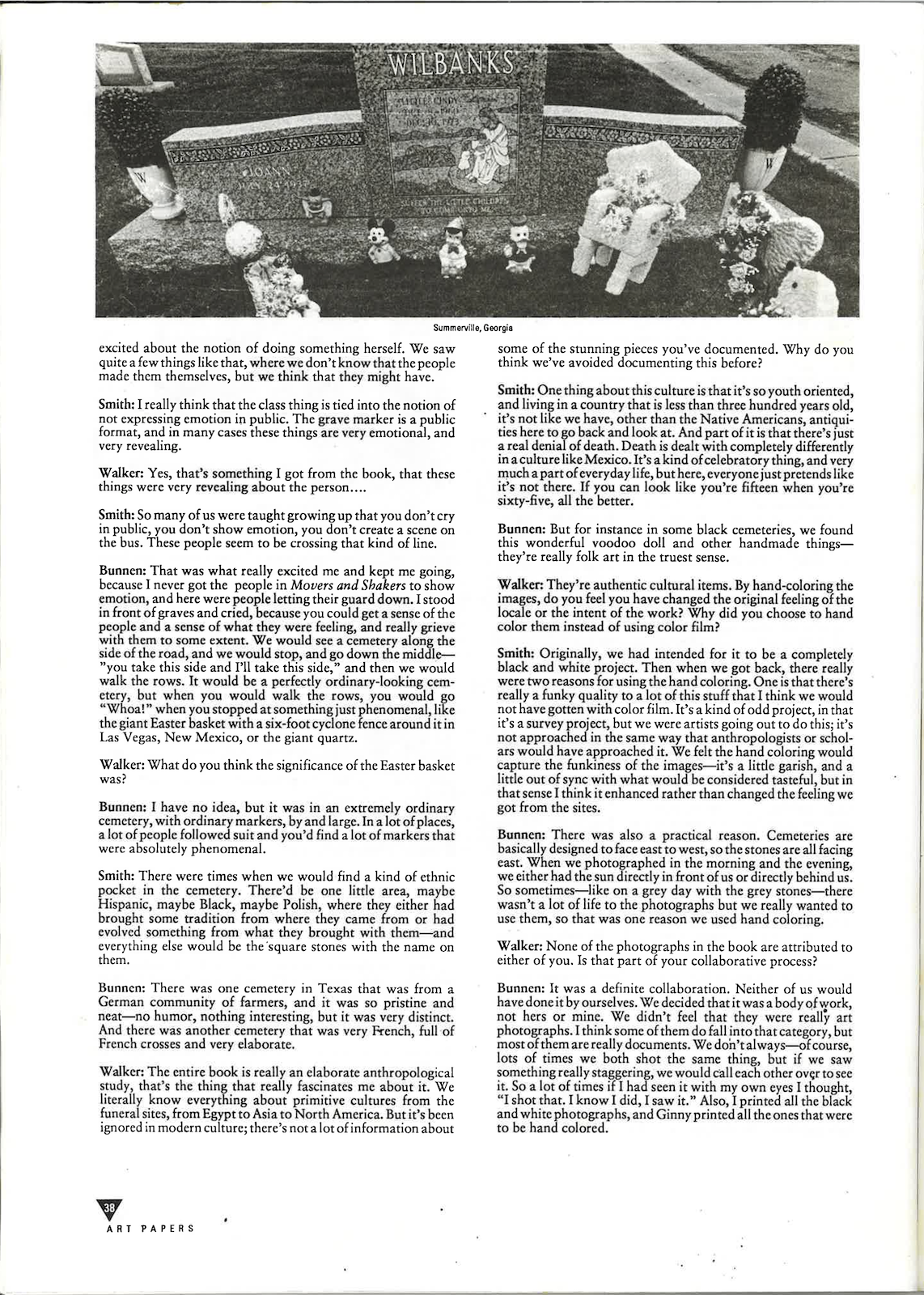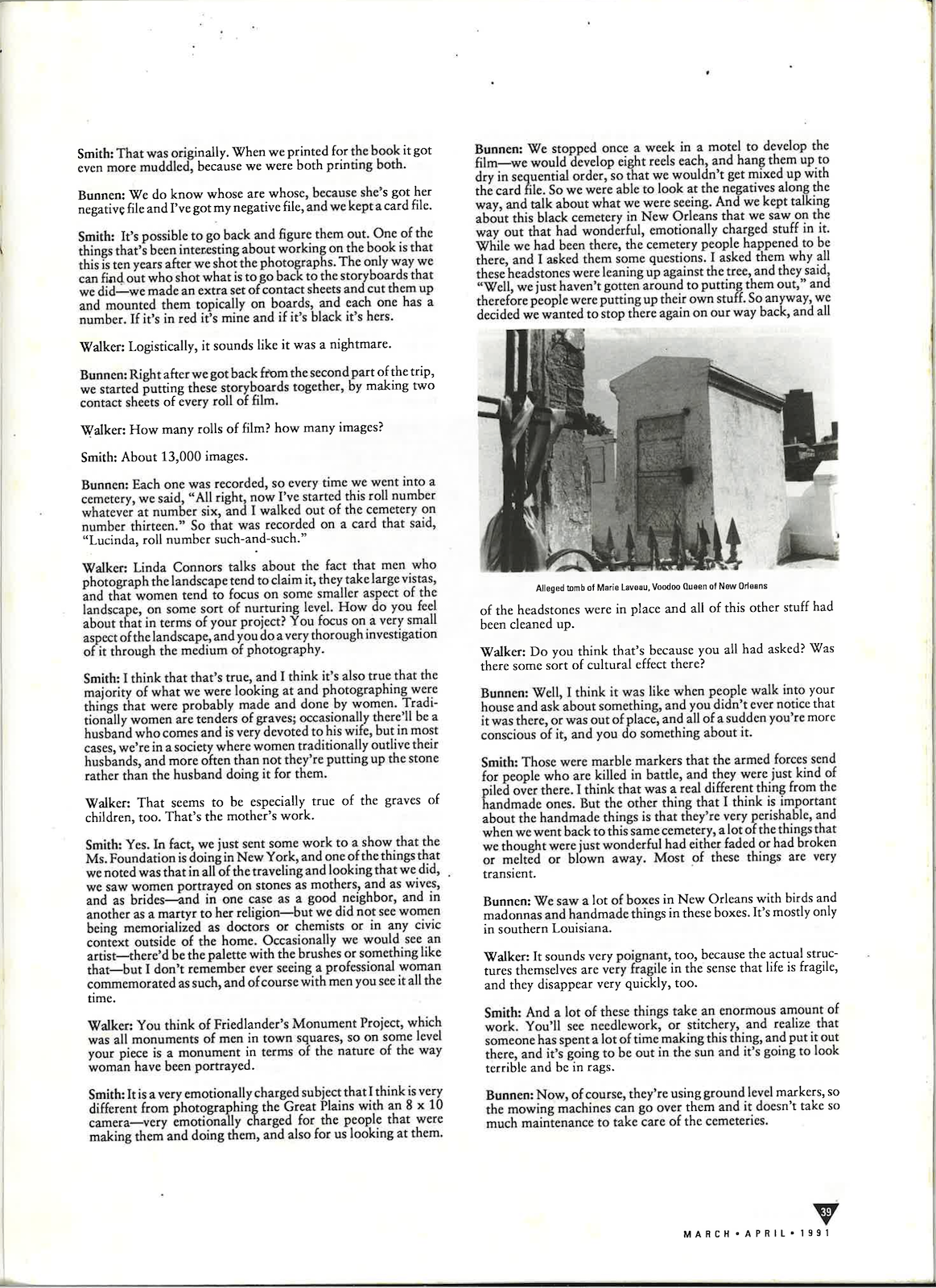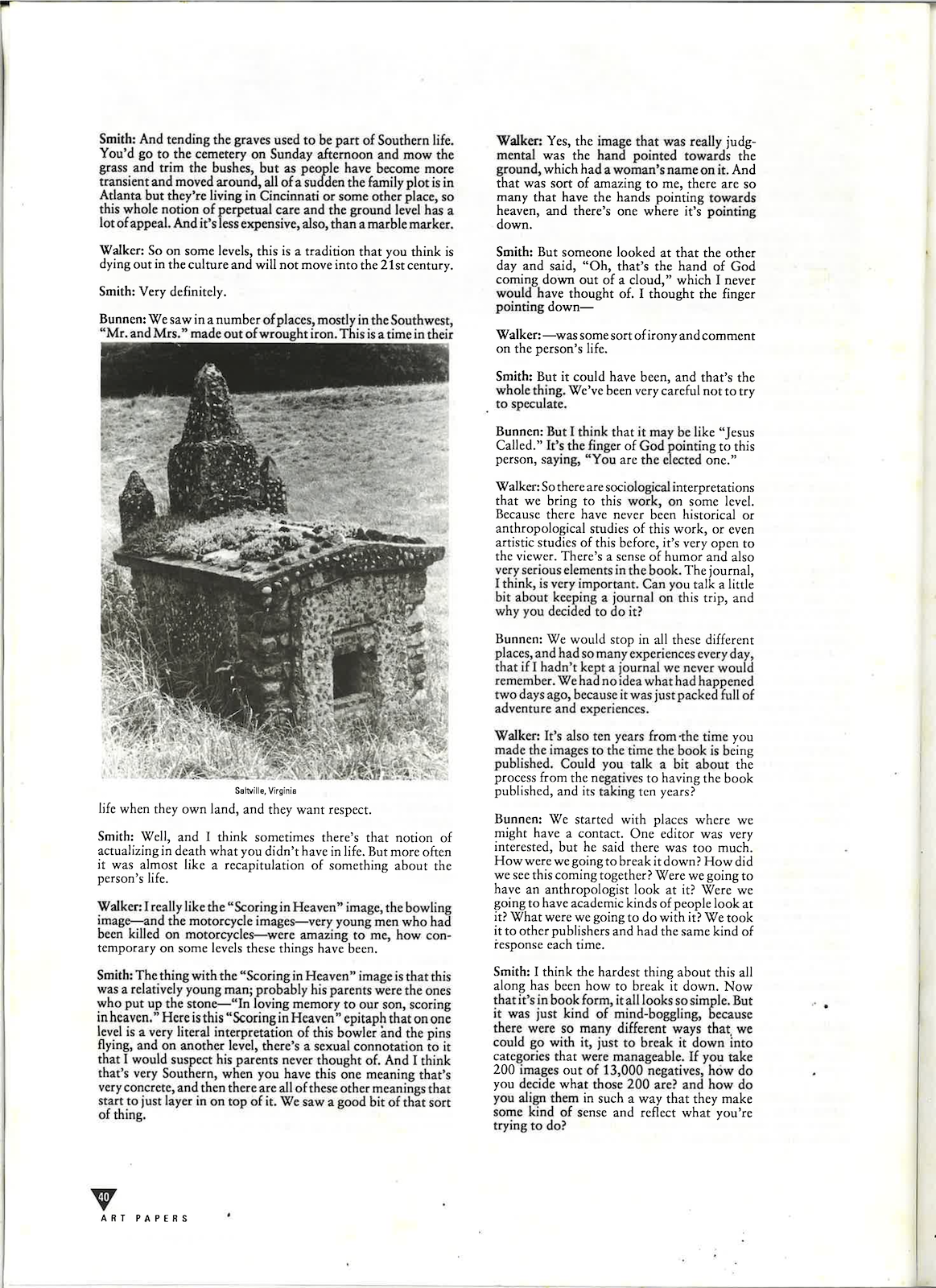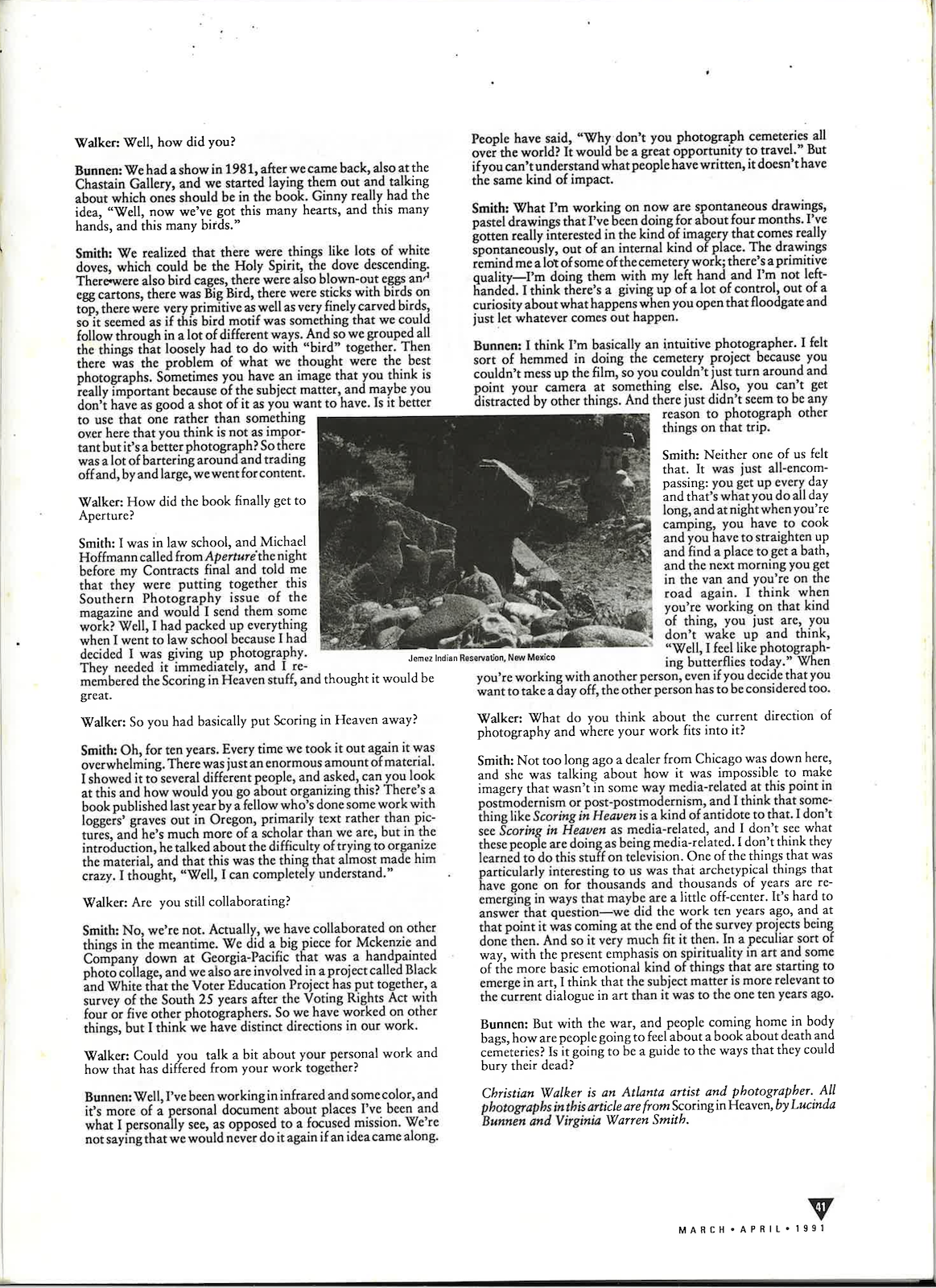Interview with Lucinda Bunnen and
Virginia Warren Smith
Share:
This interview was originally published in ART PAPERS March/April 1991, Vol. 15, issue 2.
Scoring in Heaven: Gravestones and Cemetery Art of the American Sunbelt States, by Lucinda Bunnen and Virginia Warren Smith, will be published as an Aperture Book in March, 1991.
Christian Walker: How did the idea for Scoring in Heaven originate?
Lucinda Bunnen: I had just finished doing a book called Movers and Shakers in Georgia about people who were making things happen prior to and during the Carter Administration. A lot of the people I was photographing were socialites, and I felt that their lives were emotionally very bland and that there was a facade beyond which I couldn’t get. I was looking for something real, so I started looking for metaphors to represent what I was feeling. And at that point I met Ginny Smith, who had just gotten a master’s degree at Georgia State and had a job at night, and was free in the daytime, so together we started going out to photograph. We took a couple of day trips and stopped in cemeteries, and started seeing some things that I had never seen before, and photographing them. I found all kinds of things that were what I was looking for: facades of buildings—the whole building was gone, but the facade was there. When I came back to edit all this work for the Chastain show, I spread them out and had a few friends look at them, and everybody was surprised by the images from the cemeteries. I thought, well, these people weren’t Southern either, and that’s why we all weren’t familiar with this stuff, but then when I started showing them to people who grew up here, they were surprised too. So Ginny and I started looking at more and more cemeteries. At first we did day trips, and then did a couple of overnight trips, and we thought, this is great, this is a real adventure, we need to get some kind of a vehicle so that we can travel farther. So I dreamt about a Volkswagen camper, and talked to Ginny about it, and she thought that was a great idea. I was about to turn fifty, so this was my fiftieth birthday present to myself. I was tired of the life that I was living, which was social, going to wonderful places, and wonderful tours, but they were very bland and I didn’t feel that there was much adventure involved. My children were grown, and I felt that I was entitled to do something that could be exciting and hopefully worthwhile. So I bought the van and along the way we stopped in a pet store and found Daisy, who was the last of an eleven puppy litter, the runt but beautifully marked and very appealing. And the lady in the pet store said, “Oh, of course you can travel with a dog, I travel with dogs all the time.” Well, I never heard of such a thing, but anyway, we walked out with Daisy, who was a six-week-old, adorable little puppy who also had sarcoptic mange. And the day after my fiftieth birthday, we took off. We had made a cover for the top of the van to put Daisy’s food, tanks, reels, chemistry so we could develop film along the way, set off in the pouring rain, and then realized the tarpaulin cover leaked. We stopped at Ginny’s mother’s house in Pensacola, Florida, and she said, “Are you sure you want to do this?” Anyway, we set out on our way.
Walker: And Ginny, for you how did the idea originate?
Virginia Warren Smith: Not like that. We were riding around doing the still photography and working on the script for the “Spaces and Illusions” show for the museum. Sometimes we would stop in cemeteries to eat the lunch we had taken with us—that was always a convenient, quiet, peaceful, pleasant place to stop, and occasionally we would see things around that looked interesting. I had some friends who had taken over a family flower business, and I had heard these tales about all the things that they would make, you know, the clock that stopped and the empty chair and other floral things. When we would see these things, Lucinda would say, “What’s that?” and I would say, “Oh, that’s the clock that stopped,” or “that’s the empty chair” or whatever. And as she was looking at these plastic things I was getting more and more interested in them as icons of a type of folk culture that came out of middle America—the people who were buying these things and making these things weren’t weirdoes and they weren’t folk artists and they weren’t eccentrics, they were people who had day-to-day jobs at Ford Motor Company or whatever, and yet here was this place where they were doing these things that I thought were remarkably interesting and very creative, that they would think of these things. So I got interested in it from that direction. I think we both were very interested in the idea of that whole romance of the road trip, which was really popular in the ’70s.
Walker: Right, there’s a whole lineage of that from the Farm Security Administration to Jack Kerouac to the big survey projects of the 1970s. This project is reminiscent of some of those survey projects, like the Courthouse Project or the Kentucky Project, which were very highly organized, incorporating government funding. It must have been a major undertaking. Did you anticipate how large it would become?
Bunnen: No, I didn’t. We had always talked about it being a book, and when we were camping, people would say, “Well, what are you all doing?” People got very envious of us because we had this great focus, we were working on a book about ornamentation on graves. The reason we decided to spread it to the Southwest was because I had never been there, and this seemed like a nice opportunity just to take an imaginary Mason-Dixon Line across the country and do everything that was in the southern states. And of course the Southwestern material was very different from that which we found in the Southeast.
Walker: How did you locate the sites?
Smith: We drove back roads. And of course you run into a certain number of cemeteries in the country on back roads. We would ask people. Usually when we stopped to get gas we would ask where the cemeteries were around there. In large cities we would get maps, which usually have the cemeteries marked on them. Occasionally we would ask stonecutters or people who make monuments, once or twice we even asked funeral home people. We didn’t really have a systematic way of finding them, but we found 677 of them. A lot of times we would see people in one cemetery, putting things on the grave, and we would ask them, are there any other cemeteries around here.
Walker: Did you find any trends in certain regions?
Smith: Very definitely. There are certain things that we saw over and over again, like throughout the South the motif with the telephone and something like “Jesus called and Ed answered.” Sometimes you’d see it as a plastic telephone that was actually on a floral arrangement with the receiver dangling, sometimes it would be etched on stone, sometimes it would just be written. But that was the kind of thing we saw over and over again within the South. There was a community in Fredericksburg, Texas that was the oldest Polish Catholic settlement in America, and there, we saw these incredible wire cribs. We only saw them there. There was a place out in New Mexico where someone, apparently in the area, carved birds on the tops of wooden sticks, and a lot of the graves had those on them. So sometimes it appeared to be a kind of local custom—there were some settlements along the Mexican border where they made incredible, huge wreaths out of bows. When you get into some of the religious iconography, there would be a particular saint or image particularly important in a given community, and you would go a hundred miles away and you wouldn’t see it at all.
Bunnen: One of the things I think we saw across the country was the use of daily objects like egg cartons, boxes that flowers came in, coffee cans to put flowers in—the plastic thing that holds six beer cans would be made into wreaths.
Walker: Do you have any idea how some of the personal memorials were created and put into the culture? The thing that interests me is how recent some of your images were, from graves in the ’70s. When I first heard about the book I assumed that it would be a historical book, but it’s a very recent cultural phenomenon, a lot of the images within the last fifty years.
Virginia Warren Smith, Voo Doo Dog, Hwy #301, Gainesville, FL (from Scoring in Heaven series), 1980, photograph on paper, 17.5 x 21.5 inches [courtesy of the artist and MOCA GA, Atlanta GA]
Bunnen: The reason for some of these things were economic. We ran into a couple of people who were saying that now that they had married this man with money, they were going to take Mama out of this beautiful home cemetery, where they had a homemade marker for her, and they were going to take her to the city cemetery where she could have a “proper” headstone—which would be just a carved granite thing with her name on it, very ordinary and very uninteresting. And when we talked about it, she said, “Well, you’re right. Mama probably would be happier just to stay here, and she probably would prefer to have this wonderful homemade carved piece that somebody did with love, rather than have the gravestone cutter just do this cold stone.”
Walker: There’s a whole notion of class structure, too, that this was a way for poor people and underclass and working-class people to somehow offer a memorial to their dead relatives.
Smith: Yes, and what you see too is that when you get into the slightly higher realm economically, where the people are no longer making and carving and making the beer can loops into things, that the next step up is these granite carved things—but they’re the ones that have things like “Truck Driver’s Wife” and the poems, or some kind of emblematic representation of what they did. It is a kind of working class thing that in some senses would be seen as gauche—it’s not tasteful in the same sense as having a completely bare stone with just the name on it, they’ve really personalized it in a way that, unfortunately, I think does align with class.
Bunnen: I showed the galleys to a woman in Nevada, who’s in her 80s, and she said that she had always told her kids that she just wanted to be cremated and have her ashes thrown to the wind, and after she saw the book she said, “Uh-uh, I want to change this, I want to do something creative, I want to make my own gravestone and really be creative about it.” She was very excited about the notion of doing something herself. We saw quite a few things like that, where we don’t know that the people made them themselves, but we think that they might have.
Smith: I really think that the class thing is tied into the notion of not expressing emotion in public. The grave marker is a public format, and in many cases these things are very emotional, and very revealing.
Walker: Yes, that’s something I got from the book, that these things were very revealing about the person….
Smith: So many of us were taught growing up that you don’t cry in public, you don’t show emotion, you don’t create a scene on the bus. These people seem to be crossing that kind of line.
Bunnen: That was what really excited me and kept me going, because I never got the people in Movers and Shakers to show emotion, and here were people letting their guard down. I stood in front of graves and cried, because you could get a sense of the people and a sense of what they were feeling, and really grieve with them to some extent. We would see a cemetery along the side of the road, and we would stop, and go down the middle—”you take this side and I’ll take this side,” and then we would walk the rows. It would be a perfectly ordinary-looking cemetery, but when you would walk the rows, you would go “Whoa!” when you stopped at something just phenomenal, like the giant Easter basket with a six-foot cyclone fence around it in Las Vegas, New Mexico, or the giant quartz.
Walker: What do you think the significance of the Easter basket was?
Lucinda Bunnen, Nuba, LA (from Scoring in Heaven), 1980, photograph on paper, 27.75 x 34.5 inches [courtesy of the artist and MOCA GA, Atlanta GA]
Virginia Warren Smith, Las Vegas, NM (Scoring in Heaven series), 1981, photograph on paper, 15.75 x 19.75 inches [courtesy of the artist and MOCA GA, Atlanta GA]
Bunnen: I have no idea, but it was in an extremely ordinary cemetery, with ordinary markers, by and large. In a lot of places, a lot of people followed suit and you’d find a lot of markers that were absolutely phenomenal.
Smith: There were times when we would find a kind of ethnic pocket in the cemetery. There’d be one little area, maybe Hispanic, maybe Black, maybe Polish, where they either had brought some tradition from where they came from or had evolved something from what they brought with them—and everything else would be the square stones with the name on them.
Bunnen: There was one cemetery in Texas that was from a German community of farmers, and it was so pristine and neat—no humor, nothing interesting, but it was very distinct. And there was another cemetery that was very French, full of French crosses and very elaborate.
Walker: The entire book is really an elaborate anthropological study, that’s the thing that really fascinates me about it. We literally know everything about primitive cultures from the funeral sites, from Egypt to Asia to North America. But it’s been ignored in modern culture; there’s not a lot of information about some of the stunning pieces you’ve documented. Why do you think we’ve avoided documenting this before?
Smith: One thing about this culture is that it’s so youth oriented, and living in a country that is less than three hundred years old, it’s not like we have, other than the Native Americans, antiquities here to go back and look at. And part of it is that there’s just a real denial of death. Death is dealt with completely differently in a culture like Mexico. It’s a kind of celebratory thing, and very much a part of everyday life, but here, everyone just pretends like it’s not there. If you can look like you’re fifteen when you’re sixty-five, all the better.
Bunnen: But for instance in some black cemeteries, we found this wonderful voodoo doll and other handmade things—they’re really folk art in the truest sense.
Walker: They’re authentic cultural items. By hand-coloring the images, do you feel you have changed the original feeling of the locale or the intent of the work? Why did you choose to hand color them instead of using color film?
Smith: Originally, we had intended for it to be a completely black and white project. Then when we got back, there really were two reasons for using the hand coloring. One is that there’s really a funky quality to a lot of this stuff that I think we would not have gotten with color film. It’s a kind of odd project, in that it’s a survey project, but we were artists going out to do this; it’s not approached in the same way that anthropologists or scholars would have approached it. We felt the hand coloring would capture the funkiness of the images—it’s a little garish, and a little out of syne with what would be considered tasteful, but in that sense I think it enhanced rather than changed the feeling we got from the sites.
Bunnen: There was also a practical reason. Cemeteries are basically designed to face east to west, so the stones are all facing east. When we photographed in the morning and the evening, we either had the sun directly in front of us or directly behind us. So sometimes—like on a grey day with the grey stones—there wasn’t a lot of life to the photographs but we really wanted to use them, so that was one reason we used hand coloring.
Virginia Warren Smith, Hallsville, TX (Scoring in Heaven series), 1980, photograph on paper, 15.75 x 20 inches [courtesy of the artist and MOCA GA, Atlanta GA]
Walker: None of the photographs in the book are attributed to either of you. Is that part of your collaborative process?
Bunnen: It was a definite collaboration. Neither of us would have done it by ourselves. We decided that it was a body of work, not hers or mine. We didn’t feel that they were really art photographs. I think some of them do fall into that category, but most of them are really documents. We don’t always—of course, lots of times we both shot the same thing, but if we saw something really staggering, we would call each other over to see it. So a lot of times if I had seen it with my own eyes I thought, “I shot that. I know I did, I saw it.” Also, I printed all the black and white photographs, and Ginny printed all the ones that were to be hand colored.
Smith: That was originally. When we printed for the book it got even more muddled, because we were both printing both.
Bunnen: We do know whose are whose, because she’s got her negative file and I’ve got my negative file, and we kept a card file.
Smith: It’s possible to go back and figure them out. One of the things that’s been interesting about working on the book is that this is ten years after we shot the photographs. The only way we can find out who shot what is to go back to the storyboards that we did—we made an extra set of contact sheets and cut them up and mounted them topically on boards, and each one has a number. If it’s in red it’s mine and if it’s black it’s hers.
Walker: Logistically, it sounds like it was a nightmare.
Bunnen: Right after we got back from the second part of the trip, we started putting these storyboards together, by making two contact sheets of every roll of film.
Walker: How many rolls of film? how many images?
Smith: About 13,000 images.
Bunnen: Each one was recorded, so every time we went into a cemetery, we said, “All right, now I’ve started this roll number whatever at number six, and I walked out of the cemetery on number thirteen.” So that was recorded on a card that said, “Lucinda, roll number such-and-such.”
Walker: Linda Connors talks about the fact that men who photograph the landscape tend to claim it, they take large vistas, and that women tend to focus on some smaller aspect of the landscape, on some sort of nurturing level. How do you feel about that in terms of your project? You focus on a very small aspect of the landscape, and you do a very thorough investigation of it through the medium of photography.
Smith: I think that that’s true, and I think it’s also true that the majority of what we were looking at and photographing were things that were probably made and done by women. Traditionally women are tenders of graves; occasionally there’ll be a husband who comes and is very devoted to his wife, but in most cases, we’re in a society where women traditionally outlive their husbands, and more often than not they’re putting up the stone rather than the husband doing it for them.
Walker: That seems to be especially true of the graves of children, too. That’s the mother’s work.
Smith: Yes. In fact, we just sent some work to a show that the Ms. Foundation is doing in New York, and one of the things that we noted was that in all of the traveling and looking that we did, we saw women portrayed on stones as mothers, and as wives, and as brides—and in one case as a good neighbor, and in another as a martyr to her religion—but we did not see women being memorialized as doctors or chemists or in any civic context outside of the home. Occasionally we would see an artist—there’d be the palette with the brushes or something like that—but I don’t remember ever seeing a professional woman commemorated as such, and of course with men you see it all the time.
Walker: You think of Friedlander’s Monument Project, which was all monuments of men in town squares, so on some level your piece is a monument in terms of the nature of the way woman have been portrayed.
Smith: It is a very emotionally charged subject that I think is very different from photographing the Great Plains with an 8 x 10 camera—very emotionally charged for the people that were making them and doing them, and also for us looking at them.
Bunnen: We stopped once a week in a motel to develop the film—we would develop eight reels each, and hang them up to dry in sequential order, so that we wouldn’t get mixed up with the card file. So we were able to look at the negatives along the way, and talk about what we were seeing. And we kept talking about this black cemetery in New Orleans that we saw on the way out that had wonderful, emotionally charged stuff in it. While we had been there, the cemetery people happened to be there, and I asked them some questions. I asked them why all these headstones were leaning up against the tree, and they said, “Well, we just haven’t gotten around to putting them out,” and therefore people were putting up their own stuff. So anyway, we decided we wanted to stop there again on our way back, and all of the headstones were in place and all of this other stuff had been cleaned up.
Walker: Do you think that’s because you all had asked? Was there some sort of cultural effect there?
Virginia Warren Smith, Wickenburg, AZ (Scoring in Heaven series), 1980, photograph on paper, 15.75 x 20 inches [courtesy of the artist and MOCA GA, Atlanta GA]
Bunnen: Well, I think it was like when people walk into your house and ask about something, and you didn’t ever notice that it was there, or was out of place, and all of a sudden you’re more conscious of it, and you do something about it.
Smith: Those were marble markers that the armed forces send for people who are killed in battle, and they were just kind of piled over there. I think that was a real different thing from the handmade ones. But the other thing that I think is important about the handmade things is that they’re very perishable, and when we went back to this same cemetery, a lot of the things that we thought were just wonderful had either faded or had broken or melted or blown away. Most of these things are very transient.
Bunnen: We saw a lot of boxes in New Orleans with birds and madonnas and handmade things in these boxes. It’s mostly only in southern Louisiana.
Walker: It sounds very poignant, too, because the actual structures themselves are very fragile in the sense that life is fragile, and they disappear very quickly, too.
Smith: And a lot of these things take an enormous amount of work. You’ll see needlework, or stitchery, and realize that someone has spent a lot of time making this thing, and put it out there, and it’s going to be out in the sun and it’s going to look terrible and be in rags.
Bunnen: Now, of course, they’re using ground level markers, so the mowing machines can go over them and it doesn’t take so much maintenance to take care of the cemeteries.
Smith: And tending the graves used to be part of Southern life. You’d go to the cemetery on Sunday afternoon and mow the grass and trim the bushes, but as people have become more transient and moved around, all of a sudden the family plot is in Atlanta but they’re living in Cincinnati or some other place, so this whole notion of perpetual care and the ground level has a lot of appeal. And it’s less expensive, also, than a marble marker.
Walker: So on some levels, this is a tradition that you think is dying out in the culture and will not move into the 21st century.
Smith: Very definitely.
Bunnen: We saw in a number of places, mostly in the Southwest, “Mr. and Mrs.” made out of wrought iron. This is a time in their life when they own land, and they want respect.
Smith: Well, and I think sometimes there’s that notion of actualizing in death what you didn’t have in life. But more often it was almost like a recapitulation of something about the person’s life.
Virginia Warren Smith, Liberty Hill, TX (from Scoring in Heaven), 1980, photograph on paper, 15.75 x 20 inches [courtesy of the artist and MOCA GA, Atlanta GA]
Walker: I really like the “Scoring in Heaven” image, the bowling image—and the motorcycle images—very young men who had been killed on motorcycles—were amazing to me, how contemporary on some levels these things have been.
Smith: The thing with the “Scoring in Heaven” image is that this was a relatively young man; probably his parents were the ones who put up the stone—“In loving memory to our son, scoring in heaven.” Here is this “Scoring in Heaven” epitaph that on one level is a very literal interpretation of this bowler and the pins flying, and on another level, there’s a sexual connotation to it that I would suspect his parents never thought of. And I think that’s very Southern, when you have this one meaning that’s very concrete, and then there are all of these other meanings that start to just layer in on top of it. We saw a good bit of that sort of thing.
Walker: Yes, the image that was really judgmental was the hand pointed towards the ground, which had a woman’s name on it. And that was sort of amazing to me, there are so many that have the hands pointing towards heaven, and there’s one where it’s pointing down.
Smith: But someone looked at that the other day and said, “Oh, that’s the hand of God coming down out of a cloud,” which I never would have thought of. I thought the finger pointing down—
Walker:—was some sort of irony and comment on the person’s life.
Smith: But it could have been, and that’s the whole thing. We’ve been very careful not to try to speculate.
Bunnen: But I think that it may be like “Jesus Called.” It’s the finger of God pointing to this person, saying, “You are the elected one.”
Walker: So there are sociological interpretations that we bring to this work, on some level. Because there have never been historical or anthropological studies of this work, or even artistic studies of this before, it’s very open to the viewer. There’s a sense of humor and also very serious elements in the book. The journal, I think, is very important. Can you talk a little bit about keeping a journal on this trip, and why you decided to do it?
Bunnen: We would stop in all these different places, and had so many experiences every day, that if I hadn’t kept a journal we never would remember. We had no idea what had happened two days ago, because it was just packed full of adventure and experiences.
Walker: It’s also ten years from the time you made the images to the time the book is being published. Could you talk a bit about the process from the negatives to having the book published, and its taking ten years?
Bunnen: We started with places where we might have a contact. One editor was very interested, but he said there was too much. How were we going to break it down? How did we see this coming together? Were we going to have an anthropologist look at it? Were we going to have academic kinds of people look at it? What were we going to do with it? We took it to other publishers and had the same kind of response each time.
Smith: I think the hardest thing about this all along has been how to break it down. Now that it’s in book form, it all looks so simple. But it was just kind of mind-boggling, because there were so many different ways that, we could go with it, just to break it down into categories that were manageable. If you take 200 images out of 13,000 negatives, how do you decide what those 200 are? and how do you align them in such a way that they make some kind of sense and reflect what you’re trying to do?
Walker: Well, how did you?
Bunnen: We had a show in 1981, after we came back, also at the Chastain Gallery, and we started laying them out and talking about which ones should be in the book. Ginny really had the idea, “Well, now we’ve got this many hearts, and this many hands, and this many birds.”
Smith: We realized that there were things like lots of white doves, which could be the Holy Spirit, the dove descending. There were also bird cages, there were also blown-out eggs and egg cartons, there was Big Bird, there were sticks with birds on top, there were very primitive as well as very finely carved birds, so it seemed as if this bird motif was something that we could follow through in a lot of different ways. And so we grouped all the things that loosely had to do with “bird” together. Then there was the problem of what we thought were the best photographs. Sometimes you have an image that you think is really important because of the subject matter, and maybe you don’t have as good a shot of it as you want to have. Is it better to use that one rather than something over here that you think is not as important but it’s a better photograph? So there was a lot of bartering around and trading off and, by and large, we went for content.
Walker: How did the book finally get to Aperture?
Smith: I was in law school, and Michael Hoffmann called from Aperture the night before my Contracts final and told me that they were putting together this Southern Photography issue of the magazine and would I send them some work? Well, I had packed up everything when I went to law school because I had decided I was giving up photography. They needed it immediately, and I remembered the Scoring in Heaven stuff, and thought it would be great.
Walker: So you had basically put Scoring in Heaven away?
Smith: Oh, for ten years. Every time we took it out again it was overwhelming. There was just an enormous amount of material. I showed it to several different people, and asked, can you look at this and how would you go about organizing this? There’s a book published last year by a fellow who’s done some work with loggers’ graves out in Oregon, primarily text rather than pictures, and he’s much more of a scholar than we are, but in the introduction, he talked about the difficulty of trying to organize the material, and that this was the thing that almost made him crazy. I thought, “Well, I can completely understand.”
Walker: Are you still collaborating?
Smith: No, we’re not. Actually, we have collaborated on other things in the meantime. We did a big piece for Mckenzie and Company down at Georgia-Pacific that was a handpainted photo collage, and we also are involved in a project called Black and White that the Voter Education Project has put together, a survey of the South 25 years after the Voting Rights Act with four or five other photographers. So we have worked on other things, but I think we have distinct directions in our work.
Walker: Could you talk a bit about your personal work and how that has differed from your work together?
Bunnen: Well, I’ve been working in infrared and some color, and it’s more of a personal document about places I’ve been and what I personally see, as opposed to a focused mission. We’re not saying that we would never do it again if an idea came along. People have said, “Why don’t you photograph cemeteries all over the world? It would be a great opportunity to travel.” But if you can’t understand what people have written, it doesn’t have the same kind of impact.
Smith: What I’m working on now are spontaneous drawings, pastel drawings that I’ve been doing for about four months. I’ve gotten really interested in the kind of imagery that comes really spontaneously, out of an internal kind of place. The drawings remind me a lot of some of the cemetery work; there’s a primitive quality—I’m doing them with my left hand and I’m not lefthanded. I think there’s a giving up of a lot of control, out of a curiosity about what happens when you open that floodgate and just let whatever comes out happen.
Bunnen: I think I’m basically an intuitive photographer. I felt sort of hemmed in doing the cemetery project because you couldn’t mess up the film, so you couldn’t just turn around and point your camera at something else. Also, you can’t get distracted by other things. And there just didn’t seem to be any other reason to photograph other things on that trip.
Smith: Neither one of us felt that. It was just all-encompassing: you get up every day and that’s what you do all day long, and at night when you’re camping, you have to cook and you have to straighten up and find a place to get a bath, and the next morning you get in the van and you’re on the road again. I think when you’re working on that kind of thing, you just are, you don’t wake up and think, “Well, I feel like photographing butterflies today.” When you’re working with another person, even if you decide that you want to take a day off, the other person has to be considered too.
Walker: What do you think about the current direction of photography and where your work fits into it?
Smith: Not too long ago a dealer from Chicago was down here, and she was talking about how it was impossible to make imagery that wasn’t in some way media-related at this point in postmodernism or post-postmodernism, and I think that something like Scoring in Heaven is a kind of antidote to that. I don’t see Scoring in Heaven as media-related, and I don’t see what these people are doing as being media-related. I don’t think they learned to do this stuff on television. One of the things that was particularly interesting to us was that archetypical things that have gone on for thousands and thousands of years are reemerging in ways that maybe are a little off-center. It’s hard to answer that question—we did the work ten years ago, and at that point it was coming at the end of the survey projects being done then. And so it very much fit it then. In a peculiar sort of way, with the present emphasis on spirituality in art and some of the more basic emotional kind of things that are starting to emerge in art, I think that the subject matter is more relevant to the current dialogue in art than it was to the one ten years ago.
Bunnen: But with the war, and people coming home in body bags, how are people going to feel about a book about death and cemeteries? Is it going to be a guide to the ways that they could bury their dead?
Christian Walker is an Atlanta-based artist and photographer.
